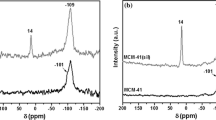Abstract
Cobalt silicate formation reduces the activity of the catalyst in Fischer–Tropsch synthesis (FTS). In this article, the effects of calcination temperature and support surface area on the formation of cobalt silicate are explored. FTS catalysts were prepared by incipient wetness impregnation of cobalt nitrate precursor into various silica supports. Deionized water was used as preparation medium. The properties of catalysts were characterized at different stages using FTIR, XRD and BET techniques. FTIR-ATR analysis of the synthesized catalyst samples before and after 48 h reaction identified cobalt species formed during the impregnation/calcination stage and after the reduction/reaction stage. It was found that in the reduction/reaction stage, metal-support interaction (MSI) added to the formation of irreducible cobalt silicate phase. Co/silica catalysts with lower surface area (300 m2/g) exhibited higher C5+ selectivity which can be attributed to less MSI and higher reducibility and dispersion. The prepared catalysts with different drying and calcination temperatures were also compared. Catalysts dried and calcined at lower temperatures exhibited higher activity and lower cobalt silicate formation. The catalyst sample calcined at 573 K showed the highest CO conversion and the lowest CH4 selectivity.



Similar content being viewed by others
References
Iglesia E (1997) Appl Catal A 161:59
Iglesia E, Soled SL, Fiato RA (1992) J Catal 137:212
Johnson BG, Bartholomew CH, Goodman DW (1991) J Catal 128:231
Fan L, Yokota K, Fujimoto K (1992) AIChE J 38:1639
Zhang J, Chen J, Ren J, Sun Y (2003) Appl Catal A 243:121
Soled SL, Baumgartner JE, Reyes SC, Iglesia E (1995) Proc Mater Res Soc Symp 368:113
Zhang Y, Liu Y, Yang G, Sun S, Tsubaki N (2007) Appl Catal A 321:79
Iler RK (1979) The Chemistry of Silica. Wiley, New York
Ming H, Baker BG (1995) Appl Catal A 123:23
Puskas I, Fleisch TH, Full PR, Kaduk JA, Marshall CL, Meyers BL (2006) Appl Catal A 311:146
Kogelbauer A, Weber JC, Goodwin JG (1995) Catal Lett 34:259
Coulter KE, Sault AG (1995) J Catal 154:56
Van Steen E, Sewell GS, Makhote RA, Micklethwaite C, Manstein H, de Lange M, O’Connor CT (1996) J Catal 162:220
Ernst B, Libs S, Chaumette P, Kiennemann A (1999) Appl Catal A 186:145
Puskas I, Fleisch TH, Kaduk JA, Marshall CL, Meyers BL (2007) Appl Catal A 316:197
Puskas I, Fleisch TH, Hall JB, Meyers BL, Roginski RT (1992) J Catal 134:615
Zhang Y, Wei D, Hammache S, Goodwin JG Jr (1999) J Catal 188:281
Jablonski JM, Wolcyrz M, Krajczyk L (1998) J Catal 173:530
Hilmen AM, Schanke D, Holmen A (1996) Catal Lett 38:143
Acknowledgments
Financial support from the National Aeronautics and Space Administration (NASA) grant (16266038-27) through a subcontract from the University of Central Florida is gratefully acknowledged. The authors would also like to thank Haito li and the nanomaterials and nanomanufacturing research center (NNRC) for help with the BET and XRD experiments.
Author information
Authors and Affiliations
Corresponding author
Rights and permissions
About this article
Cite this article
Kababji, A.H., Joseph, B. & Wolan, J.T. Silica-Supported Cobalt Catalysts for Fischer–Tropsch Synthesis: Effects of Calcination Temperature and Support Surface Area on Cobalt Silicate Formation. Catal Lett 130, 72–78 (2009). https://doi.org/10.1007/s10562-009-9903-4
Received:
Revised:
Accepted:
Published:
Issue Date:
DOI: https://doi.org/10.1007/s10562-009-9903-4




